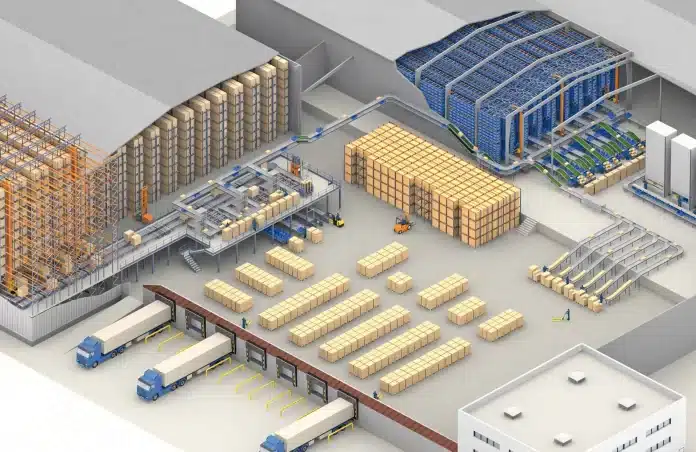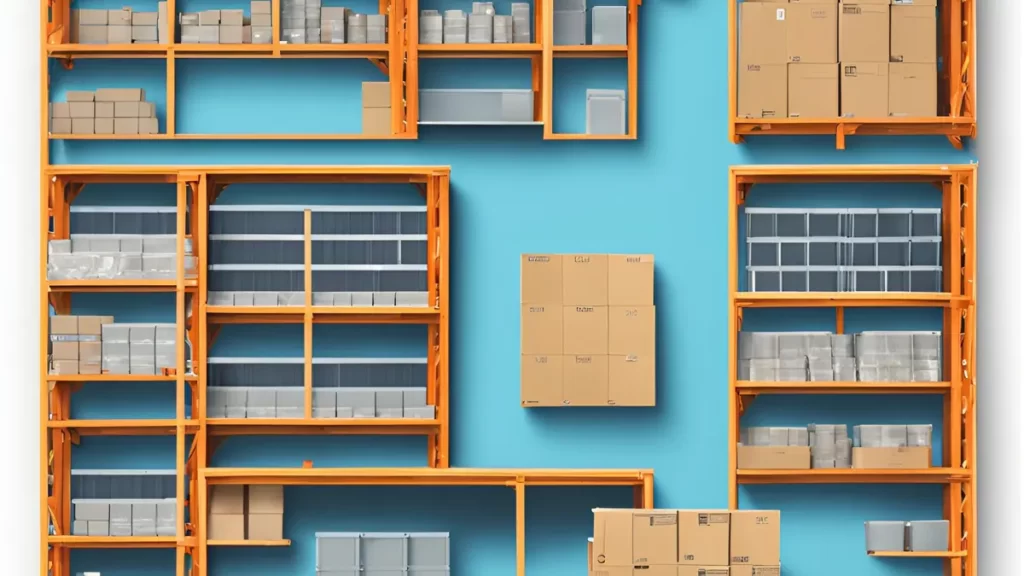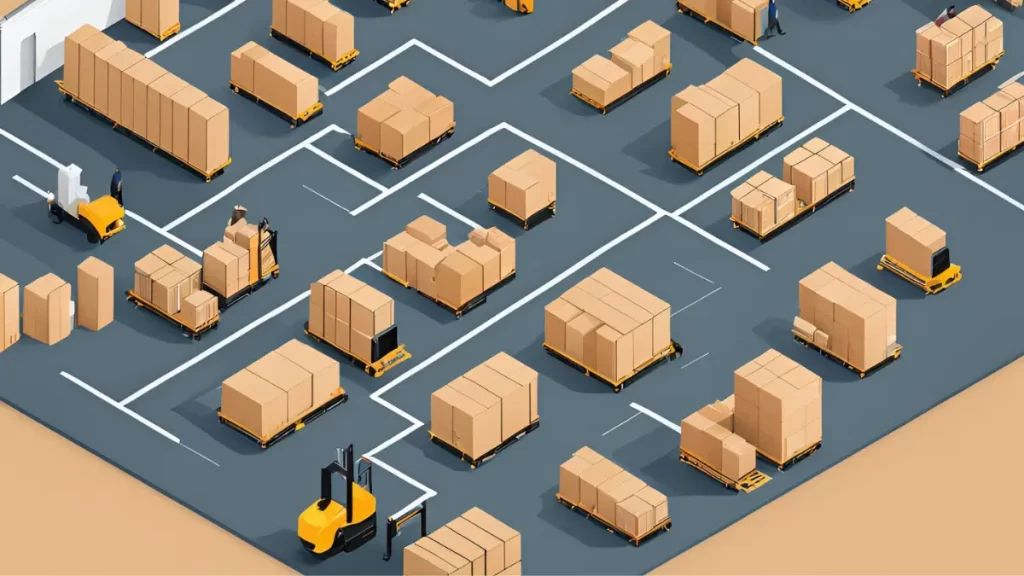When it comes to managing a warehouse, efficient space utilization is key. Warehouse layout planning plays a crucial role in optimizing your facility’s design for maximum productivity, cost efficiency, and customer satisfaction. With strategic warehouse design and optimization, you can transform your space into a well-organized and streamlined operation.
Effective warehouse layout planning involves carefully considering factors such as warehouse efficiency, space planning, and layout optimization. By optimizing the layout, you can enhance the flow of goods, minimize product handling time, and reduce operational costs. This ensures that your warehouse operates smoothly and efficiently, benefiting your entire supply chain.
Warehouse layout design takes into account various aspects, including storage areas, picking and packing areas, shipping zones, and service areas. A well-thought-out warehouse layout enables seamless movement of materials, goods, and personnel, resulting in improved workflow and productivity.
Furthermore, warehouse layout planning prioritizes safety. By adhering to safety regulations and considering ergonomic principles, you can create a safe working environment that minimizes the risk of accidents, damage to goods, and cross-contamination.
By implementing an optimized warehouse layout, you can maximize your space utilization, increase operational efficiency, and ultimately drive your business toward success. Take the first step in optimizing your warehouse by focusing on thoughtful warehouse layout planning.
Key Takeaways
|
Table of Content:
Table of Content

What Is a Warehouse Layout?
A warehouse layout refers to the arrangement of space within a facility. It determines how materials, workers, and equipment move through the space. Warehouse layout considers storage, picking, shipping, and office areas, as well as the size and shape of items and potential obstacles. A well-designed warehouse layout optimizes storage, movement, and retrieval of goods, enhancing operational efficiency.
When planning a warehouse layout, facility arrangement plays a crucial role in achieving space optimization, efficient flow of production and distribution, and organized storage. The placement of equipment within the warehouse should be strategically planned to ensure ease of access and maximize productivity. An optimized layout not only improves workflow and enhances productivity but also minimizes the time and effort required for inventory retrieval and storage organization.
A well-designed warehouse layout takes into account the flow of production and distribution within the facility. It ensures that materials and products can be easily accessed and moved from one area to another, minimizing bottlenecks and delays. This not only improves productivity but also ensures timely delivery to customers.
Efficient storage organization is another key aspect of warehouse layout planning. By grouping similar products together and arranging them strategically, a warehouse can optimize storage space and reduce unnecessary movement. This results in streamlined operations, reduced costs, and increased overall efficiency.
In conclusion, a warehouse layout is a critical component of an efficient and well-organized facility. It involves careful consideration of facility arrangement, space optimization, flow of production and distribution, storage organization, and equipment placement. By designing a warehouse layout that prioritizes efficiency and productivity, businesses can enhance their operations and streamline their supply chain.
Warehouse Layout Explained
A warehouse layout is a strategic plan for efficient storage, retrieval, and movement of goods. It is crucial for organization and operational efficiency. Optimizing the layout streamlines workflow enhances goods retrieval, and maximizes space utilization.
Key considerations in warehouse layout planning include:
- Efficient Storage: Allocate appropriate storage areas based on product requirements, such as temperature control for perishable goods or specific shelving systems.
- Goods Retrieval: Design the layout to ensure smooth, efficient movement of materials and products, reducing travel distances and picking time.
- Warehouse Organization: Strategically place aisles, racks, and equipment to maintain a logical flow of materials, minimizing congestion and reducing errors or accidents.
- Workflow Optimization: Consider the flow of materials from receiving to storage, picking, and shipping. Identify and eliminate bottlenecks to support seamless operations.
Integrating advanced warehouse management systems (WMS) can further enhance warehouse layouts. WMS automates inventory management, optimizes picking routes, and provides real-time visibility, leading to higher efficiency, accuracy, and cost savings.
Warehouse layout planning requires careful analysis of various factors. By focusing on these elements, businesses can create a well-structured, highly functional warehouse.
Why Warehouse Layout Is Important
The efficiency and productivity of a warehouse are directly influenced by its layout. A poorly designed warehouse can result in low productivity, inventory losses, and accidents, leading to increased costs and decreased customer satisfaction. On the other hand, an optimized layout can significantly improve efficiency, reduce costs, enhance customer satisfaction, and promote safety.
An optimized warehouse layout enables quick and efficient storage, retrieval, and movement of goods. By considering ergonomic principles, clear traffic pathways, and separate areas for hazardous materials, you prioritize safety and reduce the risk of accidents and injuries. Additionally, well-planned layouts minimize the chances of cross-contamination and damage to goods, ensuring product quality and customer satisfaction.
Efficient warehouse layouts increase productivity by enabling streamlined operations and minimizing wasted time and effort. With a well-organized layout and barcode tracking software, employees can easily locate and access items, reducing search time and improving order fulfillment speed. This integration leads to faster order processing, shorter lead times, and ultimately, higher customer satisfaction.
An optimized layout also contributes to cost reduction. By minimizing the distance traveled for picking, packing, and shipping operations, warehouse efficiency improves, resulting in reduced labor costs and increased throughput. Additionally, effective space utilization in a well-planned layout can lead to optimal inventory storage, eliminating the need for unnecessary expansion and reducing holding costs.
Overall, investing time and effort in designing an efficient and optimized warehouse layout is essential for businesses aiming to maximize productivity, reduce costs, ensure customer satisfaction, and prioritize safety.
Components of a Warehouse
A well-organized warehouse is essential for efficient operations. It consists of several key components strategically placed within the layout. Each area serves a specific purpose, contributing to the overall functionality of the warehouse.
The receiving area is where shipments are unloaded and checked for accuracy and condition. It is crucial to have a dedicated space for receiving goods to ensure a smooth and streamlined process.
The storage area is where inventory is stored until it’s ready to be picked. Proper storage techniques and shelving systems play a significant role in maximizing space and ensuring efficient inventory management.
The packing area is where orders are prepared for shipping. This area should be equipped with packing stations, packaging materials, and tools to facilitate the packaging process.
The shipping area is responsible for preparing orders for distribution. It includes shipping stations, labeling equipment, and loading docks to ensure timely and accurate shipments.
In addition to these core areas, warehouses may also have service areas that support the daily operations of the facility. Service areas may include restrooms, break rooms, offices for administrative tasks, and employee facilities.
Depending on the nature of the business, warehouses may include additional areas such as staging or special handling areas to accommodate specific requirements. These areas are designed to cater to unique needs, such as product assembly, quality control, or hazardous materials handling.
Having a well-planned layout with strategically placed warehouse components enhances efficiency, productivity, and safety within the facility. Each component plays a vital role in the overall success of warehouse operations.
Warehouse Layout Considerations
When designing a warehouse layout, consider several key factors to ensure efficiency and productivity. The type of operation—whether manufacturing, e-commerce, or distribution—will greatly impact the layout, as each requires a unique design to optimize processes. Product storage requirements are crucial, as different products may need specialized storage systems like racks, shelves, or temperature-controlled areas.
Equipment needs must be thoroughly evaluated, integrating machinery and technology into the layout to improve efficiency. Assess the available space and strategically place storage areas, aisles, and workstations to optimize space utilization.
Analyze the workflow to minimize unnecessary travel and ensure a logical flow of goods, leading to smooth operations. Safety regulations and compliance with industry standards are paramount; incorporate clear pathways, proper lighting, and designated hazardous material areas to prevent accidents and ensure a safe working environment.
Cost efficiency is another key consideration; a well-planned layout can reduce travel, streamline processes, and save costs. Implementing a Warehouse Management System (WMS) can further aid in optimizing the layout by providing real-time inventory visibility and automating processes. By considering these factors, you can create an efficient, productive, and safe warehouse environment.
Types of Warehouse Layouts/Warehouse Layout Examples
Different warehouse layouts can be used based on your business needs. Let’s explore some popular examples:
U-Shaped Warehouse Layout
The U-shaped warehouse layout is characterized by having the loading and unloading areas on the same side, forming a U-shaped flow. This layout allows for efficient movement of goods, as it minimizes the distance traveled by workers and equipment. It also enables easy visibility and accessibility to different areas of the warehouse. The U-shaped layout is particularly suitable for small to medium-sized warehouses with limited space.
L-Shaped Warehouse Layout
The L-shaped warehouse layout features separate reception and dispatch areas, forming an L-shaped flow. This layout allows for a more organized and controlled movement of goods within the warehouse. It ensures a smooth flow of materials from the receiving area to the storage area and then to the shipping area.Warehouses with a higher volume of inventory and a need for strict segregation of incoming and outgoing goods commonly use the L-shaped layout.
I-Shaped Warehouse Layout
The I-shaped warehouse layout has the reception and dispatch areas located on opposite sides of the warehouse, forming a straight flow. This layout is ideal for warehouses with a linear workflow, where goods move in a straight line from one end to the other. It provides a clear and direct pathway for material movement, reducing travel time and enhancing efficiency. The I-shaped layout is often utilized in larger warehouses with high-volume operations.
When deciding on the right warehouse layout for your business, consider factors such as available space, product flow, and operational requirements. Each layout has its own advantages and should be tailored to your specific needs.
Tips on Critical Aspects of Logistics and Warehouse Functions
When it comes to optimizing your warehouse layout, there are several critical aspects of logistics and warehouse functions that you should consider. By addressing these key factors, you can maximize efficiency, reduce costs, and improve overall operational performance.
Throughput Evaluation
Conducting a thorough evaluation of your warehouse’s throughput is essential in identifying areas for improvement. By analyzing the flow of materials and identifying any bottlenecks or inefficiencies, you can implement strategies to optimize the movement of goods and streamline your operations.
Product Requirements
Understanding the specific requirements of your products is crucial in determining the need for specialized storage systems and value-added services. Tailor your warehouse layout to ensure different types of products are stored appropriately and easily accessible when needed.
Appropriate Storage Systems
Choosing the right storage systems for your warehouse plays a significant role in optimizing space utilization and promoting efficient material handling. Whether it’s selective pallet racking, mezzanine storage, or automated systems, selecting the appropriate storage solution can enhance productivity and improve inventory management.
Space Assessment
Conducting a comprehensive assessment of your warehouse space is paramount in optimizing layout design. By analyzing the available space and considering future expansion possibilities, you can make informed decisions about space allocation and ensure efficient use of your warehouse’s footprint.
WMS Implementation
Implementing a warehouse management system (WMS) can greatly aid in optimizing your warehouse layout. A WMS provides real-time visibility into inventory, facilitates efficient order processing, and enables effective space utilization, ultimately improving overall operational efficiency.
Demand Forecasting
Accurate demand forecasting is essential in warehouse layout optimization. By analyzing historical data and market trends, you can anticipate future demand patterns and adjust your layout accordingly. This ensures that you have the necessary resources and space to meet customer needs efficiently.
Palletizing Strategy
Developing an effective palletizing strategy can significantly enhance your warehouse’s efficiency and storage capacity. By implementing standardized palletizing procedures and optimizing stacking patterns, you can maximize space utilization and simplify warehouse operations.
Seasonality Maintenance
Warehouse operations can be influenced by seasonal fluctuations in demand. By incorporating seasonality maintenance into your layout design, you can allocate space for increased inventory during peak seasons and optimize resource allocation throughout the year.
Engaging with Subject Matter Experts
Collaborating with subject matter experts and industry professionals can provide valuable insights and recommendations for optimizing your warehouse layout. Their expertise and experience can help you make informed decisions, implement best practices, and stay updated with the latest industry trends.
By focusing on these critical aspects of logistics and warehouse functions, you can effectively optimize your warehouse layout and achieve significant improvements in efficiency, productivity, and cost-effectiveness.
How Cloud-First and AI-Powered Warehouse Management Systems Help Optimize Warehouse Layout
Cloud-first and AI-powered warehouse management systems (WMS) offer a range of benefits that contribute to optimizing warehouse layout and improving overall efficiency. By harnessing data analysis capabilities, these systems provide valuable insights that enable you to make informed decisions about warehouse operations.
One key area where WMS excels is in improving stock rotation. Through real-time data analysis, these systems can identify slow-moving inventory and recommend appropriate actions to ensure efficient utilization of warehouse space. By optimizing stock rotation, you can minimize waste and maximize the use of available storage capacity.
Another significant advantage of cloud-first and AI-powered WMS is their ability to facilitate material movement. With advanced algorithms and machine learning capabilities, these systems streamline the movement of goods within the warehouse. By optimizing pick routes and minimizing unnecessary movement, you can reduce operational costs and increase productivity.
Furthermore, these WMS solutions enable you to gain better control over warehouse operating costs. By leveraging data analysis, you can identify areas of inefficiency and implement measures to reduce expenses. This includes optimizing labor utilization, reducing energy consumption, and improving overall resource allocation.
Overall, cloud-first and AI-powered WMS offer numerous benefits that contribute to optimizing warehouse layout and improving operational efficiency. By leveraging data analysis, facilitating stock rotation, streamlining material movement, and reducing operating costs, these systems enhance the overall efficiency of your warehouse operations.
Conclusion
In conclusion, effective warehouse layout planning is pivotal for maximizing space utilization, enhancing operational efficiency, and ensuring safety within a warehouse. By meticulously considering factors such as space optimization, workflow, and safety regulations, businesses can create a well-organized facility that drives productivity and cost savings. An optimized layout not only improves the flow of goods and minimizes handling time but also ensures a safer working environment, ultimately contributing to the success of the entire supply chain.
To experience the benefits of an optimized warehouse layout firsthand, we invite you to try a free demo of HashMicro‘s Warehouse Management System. With our advanced software solutions, you can streamline your warehouse operations, boost efficiency, and transform your facility into a highly productive space. Take the first step towards warehouse optimization today with HashMicro.


























































